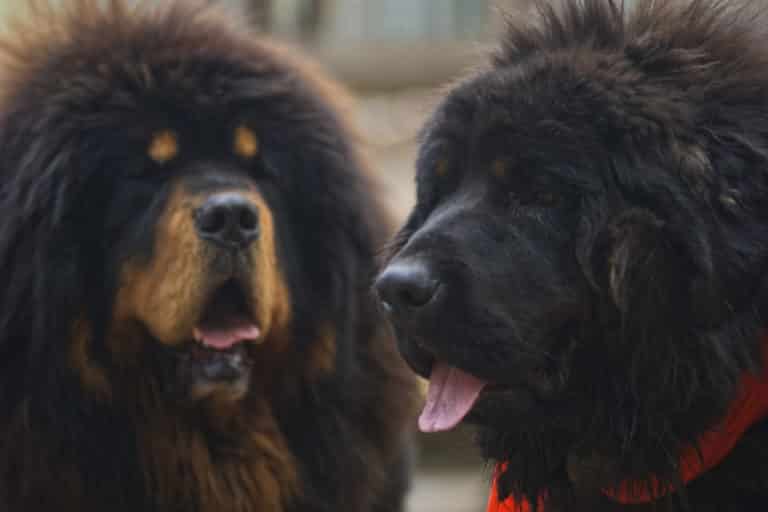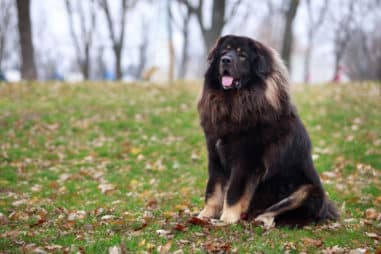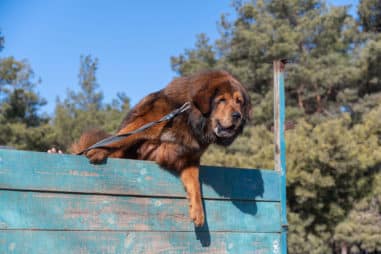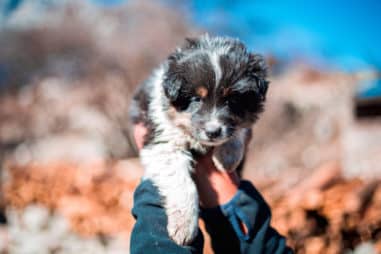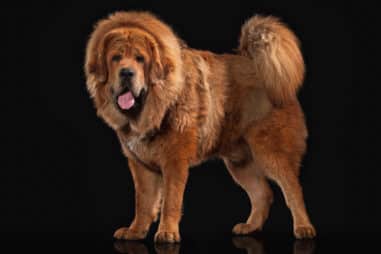You’re a big fan of dogs and you’re thinking of introducing one to your family … the Tibetan Mastiff got your attention. Do you have what it takes to tame this massive beast of the dog kingdom?
The Tibetan Mastiff is a rare and expensive breed among canines. They’re known for their size, strength, and loyalty. Add this dog’s protective nature into the mix and you’ve got yourself a bodyguard.
What Is a Tibetan Mastiff?
Tibetan Mastiffs originated from the high altitudes of Tibet. But they’re not part of the Mastiff breed as the name suggests. The Europeans who came to Tibet used the term Mastiff to refer to large dog breeds.
Their size has made them effective guardians of temples and livestock. Similar to wolves, they are primitive and fierce protectors of their territory. Despite their fierceness, domesticating them is possible.
What Does a Tibetan Mastiff Look Like?
Tibetan Mastiffs are large dogs with double coats. They have short to medium, and sometimes long hair. The mane that covers their neck and shoulders looks similar to a lion’s mane.
Their size is hard to ignore because Tibetan Mastiffs are big dogs. A male Tibetan Mastiff stands at 26 inches in height and could weigh 100 to 160 pounds (66 cm and 45–73 kg, respectively). The female is about 24 inches tall and could weigh 75 to 125 pounds (61 cm and 34–57 kg, respectively).
Some Tibetan Mastiffs have wrinkly skin on their faces. Breeders call them monastery dogs or “Tsang-khyi” (dogs from Tsang). The tighter-skinned ones are called “Do-khyi.”
What Color Are Tibetan Mastiffs?
The color of a Tibetan Mastiff can range from black, brown, grey, and gold. Their coats can have different shades and pure colors. Puppies are usually darker than adults because of the puppy fuzz.
The breeding techniques and genetics can affect a dog’s coat color. Crossbreeding will alter some features of a dog including its fur. If you are looking for a purebred, a DNA test is usually done to determine purity.
The Do-khyi Mastiffs come in a variety of colors while the Tsang-khyi has fewer. Tsang-khyi dogs are considered true Tibetan Mastiffs and their common colors are black with tan markings and brown. Pure brown coats are more common than pure black and pure white or cream coats.
What Is the Most Popular Color of Tibetan Mastiffs?
The most common and popular color of a Tibetan Mastiff is in the shades of brown and gold. Because of their color and massive size, some people thought they were bears. Some have a paler shade of brown while the others have bright, reddish coats.
Pure Tibetan Mastiffs usually have black fur with tan marks. A dog’s color is usually dependent on genetics. Because of the dilution of genes, the variety of colors becomes wider.
What Is the Rarest Tibetan Mastiff Color?
A pure black coat is very rare among Tibetan Mastiffs. Most black Tibetan Mastiffs have tan markings on their chest, legs, and ears. But a pure black Mastiff is uncommon.
On the lighter shades, cream and white are rare for Tibetan Mastiffs. Because of the unusual shades, the purity of the said Mastiff might be in question. These colors appear as results of crossbreeding and genetic anomalies.
Don’t be fooled by a puppy’s coat color because this will change during adulthood. Some dogs used to have darker fur when they were puppies. This is caused by what they call the puppy fuzz.
What Color Eyes Do Tibetan Mastiffs Have?
Like the color of their coats, the color and shade of their eyes can vary as well. Tibetan Mastiffs’ eyes come in different shades of brown. Your Mastiff’s eyes could be on the lighter or darker side but brown nonetheless.
Their eyesight is not as vivid as human eyesight. They can only see two primary colors and it’s called dichromatic vision. If they are struggling with their vision, they should be treated right away.
Do Tibetan Mastiffs Have Tails?
A Tibetan Mastiff’s tail is medium in length and covered by fur. The tail’s color matches the color of its coat. Tibetan Mastiffs’ tails are curled and usually touch their backs.
The season can affect the thickness of fur on their tails. During the warmer months of the year, they shed the excess hair from their coats. That will include the excess hair from their tails.
They do wag their tails just like most dogs. This is an expression of excitement and joy. If the tail is tucked between their legs it’s a sign of worry or fear.
Are Tibetan Mastiffs Born With or Without Tails?
Tibetan Mastiffs are born with tails. This part of the body is already prominent at a young age. The tail’s length is proportional to the size of their bodies.
It is thicker during the colder months because of the winter coat. Shedding of their tail’s fur will coincide with the rest of the coat’s shedding. Grooming them is easy since they do shed once or twice a year.
How Long Are Tibetan Mastiff Tails?
The length of their tails can grow from medium to long. Tibetan Mastiffs are double-coated dogs with tails that curl upwards. Because of the amount of fur, their tails are heavier than the tails of single-coated dogs.
Do Tibetan Mastiff Tails Curl?
Don’t fret about the curled-up tails of Tibetan Mastiffs. It’s natural. And as funny as it sounds, the tail’s position exposes their behinds. The curvature sometimes causes their tails to touch their backs.
Imagine a short spiral. That’s what a Tibetan Mastiff’s tail looks like. This appearance is not a cause for concern because it’s normal.
What Do Tibetan Mastiff Puppies Look Like?
Tibetan Mastiff puppies are small just like the other young dogs. A newborn only weighs 5 to 10 pounds (2–5 kg). But after 12 to 18 months they’ll turn into big, glorious beasts.
Puppies are more energetic and playful. You can’t tell what the color of their coats will be during this period. They have darker coats than the older Tibetan Mastiffs but the tail is already prominent.
How Long Do Tibetan Mastiffs Look Like Puppies?
Tibetan Mastiffs grow slower than the other dogs. At 6 to 8 months, they still possess the characteristics of a puppy. Their growth usually stops at 18 months of age and the playfulness will decrease.
The changes are gradual and not very noticeable during the first few months. When they hit the 12-month mark, that’s when you’ll see how big they’ve grown. They’re still growing at this point, becoming stronger and more serious.
What Type of Breed Is a Tibetan Mastiff?
Tibetan Mastiffs belong in the primitive breed of canines with pack behavior like wolves. They are tough as nails, and that helped them survive the harsh conditions back in Tibet. They were bred as guard dogs to protect the temples and livestock.
They’re classified as large dogs because of their recognizable size. Without training, this breed is dangerous because their wild, territorial side is still intact. If you come across a Tibetan Mastiff that doesn’t know you, be careful with your movements.
What Are the Different Types of Tibetan Mastiffs?
They’re not real Mastiffs but the name has been used to describe large dogs. Tibetan Mastiffs are divided into two groups. The Do-khyi and the Tsang-khyi.
Do-khyi is the more common and domesticated type of Tibetan Mastiff. The color of their coats is more diverse and their facial skin is tighter. This could be a result of the dilution of genes.
The Tsang-khyi (the dog from Tsang) on the other hand, have wrinkly facial skin. They are called monastery-type dogs and have fewer variations in their coats. This type is considered a pure form of Tibetan Mastiff that some breeders claim has lion’s blood.
What Group Does the Tibetan Mastiff Belong to?
Tibetan Mastiffs belong to flock guardian breeds. They are the types that were bred to watch and protect livestock and other properties. Among the other dogs of this type, they’re one of the strongest.
Tibetan Mastiffs don’t have the speed of hunting dogs. But their brute force and courage are enough to keep the intruders away. A single bite of a Tibetan Mastiff has enough force to cause a serious injury.
There are different categories for dogs according to size. Some belong to the teacup, toy, small, medium, and large, or giant dog category. The Tibetan Mastiff belongs to the large category, and in boxing terms, the heavyweight division.
Is a Tibetan Mastiff a Snub Nose Dog?
A Tibetan Mastiff is a snub-nosed dog. Snub-nosed dogs are called brachycephalic breeds. Brachycephalic breeds have short and sometimes almost flat muzzles.
Being a snub-nosed dog makes a Tibetan Mastiff more prone to respiratory issues. You’ll notice that they snore more than the dogs with long and pointed noses. Confining your Tibetan Mastiff in a small space can lead to breathing difficulties.
Are Tibetan Mastiffs Purebred?
Tibetan Mastiffs are not real Mastiffs and came from a breed of their own. They got the name from Europeans who used the name as a reference to big dogs. English Mastiffs are not directly related to them.
The purebreds came from the mountainous areas of the Himalayan region. They’re not as tame and domesticated as their western counterparts. Though loyal to their owners, they still have the aggression of wild dogs.
How Do I Know if My Tibetan Mastiff Is Purebred?
You need to inspect the appearance of your Tibetan Mastiff to see signs of being purebred. Purebreds are called Tsang-khyi or monastery dogs. This type of Mastiff is a flock guardian dog that came from the east.
This Tibetan Mastiff has more wrinkly skin on its face than the Do-khyi type. But the best way to find out is through DNA testing. Talk to a reputable breeder about the said test to find out if your dog is purebred.
Is There a Tibetan Mastiff Crossbreed?
Crossbreeding is a practice where two separate breeds mate and give birth to a new breed. The offspring will get the combined attributes of its parents and becomes a unique dog. The genes of a Tibetan Mastiff have been paired with countless dog breeds.
The breeds include German Shepherd, Great Dane, Saint Bernard, Siberian Husky, and more. Because of the Tibetan Mastiff’s powerful status, they’ve been labeled as lions.
But unregulated crossbreeding is being frowned upon by some organizations. This is because of the risks involved with crossbreeding. The dilution of genes that happened between two breeds can result in health problems.
What Breeds Created the Tibetan Mastiff?
DNA evidence revealed that Tibetan Mastiffs have been around for 5,000 years. With their primitive characteristics still intact, it’s safe to assume that they’re from a pure breed. Crossbreeding has expanded this breed in the West.
If you are looking for a purebred, getting in contact with a breeder is advised. Or you can visit the high altitudes of their homeland if you want some adventure too.
Where Did Tibetan Mastiffs Originate?
Tibetan Mastiffs originated from the mountains of the Himalayan region. Mountain dogs and monastery dogs are among the names that have been used to refer to them. The Tibetan Mastiff name was given by Europeans who traveled there.
They’ve been bred to guard livestock and monasteries. Tibetan Mastiffs are loyal but they let their wild side loose when it comes to strangers. Because of their pack mentality, they are territorial.
When Were Tibetan Mastiffs First Bred?
The first recorded history of the Tibetan Mastiff was written during the 19th century. But research shows that they’ve been around longer than that. They may have been roaming the earth for 5,000 years as DNA tests reveal.
The breeding may have coincided with the appearance of monasteries and villages. Monks and villagers have domesticated them as guard dogs. This is to protect the area from unwanted visitors.
Why Were Tibetan Mastiffs Bred?
The locals did not adopt them just for the sake of having pets. They’ve been bred as flock guardian dogs. Their territorial, protective nature is excellent for watching big areas of land.
At some point, their population became big that it started causing problems. Some of them were not domesticated and they started attacking random people. Tibetan Mastiffs are more dangerous when they lack training and interaction with humans.
What Are Tibetan Mastiffs Bred for Today?
Tibetan Mastiffs are still being bred for the same reason in the modern age. They’re still effective as guard dogs. Though more domesticated, they’re still in touch with their primitive side.
Some people adopt them as companions or pets. Because they came from a rare breed, Tibetan Mastiffs are expensive. The most expensive dog that has been sold is a Tibetan Mastiff.
Nowadays, having a Tibetan Mastiff is not just about protection. Their presence is their owner’s way of making a statement. The wealthy families in China are adopting them as status symbols.
Is a Tibetan Mastiff a Hunting Dog?
Tibetan Mastiffs are flock guardian or livestock guardian dogs (LGD). They are different from hunting dogs. Hounds and terriers belong to this category but not the Tibetan Mastiff.
Hunting dogs are usually smaller and more agile than their guardian peers. Their size is an advantage in catching their prey. But Tibetan Mastiffs are large dogs and they don’t possess the ideal speed for hunting.
What Kind of Animals Do Tibetan Mastiffs Hunt?
They may lack the speed of hunting dogs but their strength is impressive. Because of their size and frightening bite force, they can take an invader down with ease. Tibetan Mastiffs are more than happy to sniff around but they’ll attack at the first sign of trouble.
They are guardian dogs by default and hunting is not their specialty. Although they’re not natural hunters, they’re more than ready to protect their turf. Tibetan Mastiffs are known for being fearless and they won’t back down easily from other animals.
How Much Better Can Tibetan Mastiffs Smell Than Humans?
Dogs have a stronger sense of smell than humans. Scientists say that a dog’s sense of smell is 40 to 1,000 times stronger than a human’s. Your Tibetan Mastiff is not so different.
If you’re about 10 feet (3 m) away from your dog, you cannot smell him. But at such distance, your Tibetan Mastiff can already detect your scent.
The sense of smell is crucial to the survival of canines. It helps them detect any threat within their vicinity so they can protect themselves. It is also useful when they’re looking for food.
Are Tibetan Mastiffs Good Watchdogs?
Tibetan Mastiffs will do everything to protect their owner and the property they’re in. With their loyalty and vigilance, they fit the bill as good watchdogs. Tibetan Mastiffs are calm in the company of their owners but aloof toward strangers.
Their protection is one of the reasons why they’ve been bred back in Tibet. These adorable-looking giants can turn into ruthless monsters when the situation calls for it. Being reckless around a Tibetan Mastiff that you don’t know is a recipe for disaster.
Do Tibetan Mastiffs Make Good Therapy Dogs?
Therapy dogs are the ones that provide emotional support. They are in charge of cheering people up in hospitals and retirement homes. Tibetan Mastiffs are not very affectionate, but with training, being a therapy dog is possible.
It all boils down to the type of training they’ve got. Some were trained as guards, and some were trained as pets and therapy dogs. A Tibetan Mastiff who’s more used to being a watchdog may put patients at risk.
Don’t forget that Tibetan Mastiffs don’t warm up easily with strangers. Before deciding to make your dog volunteer as a therapy dog, discuss it with a trainer. This is to stop any attacks from happening.
Do Tibetan Mastiffs Make Good Service Dogs?
Service dogs are somehow similar to therapy dogs but there’s a difference. While therapy dogs provide emotional support, service dogs are in charge of more practical tasks. Since a Tibetan Mastiff is not very affectionate, being a service dog is more suitable.
As a service dog, he is expected to assist people with disabilities. This job would require training and socialization. Tibetan Mastiffs are intelligent dogs so they can deal with the tasks at hand.
If you are confident that your Tibetan Mastiff can deliver, give it a try. Make sure that he’s already comfortable with strangers while keeping his stubborn nature locked away. It’s a win-win situation because he can fight boredom by helping people.

